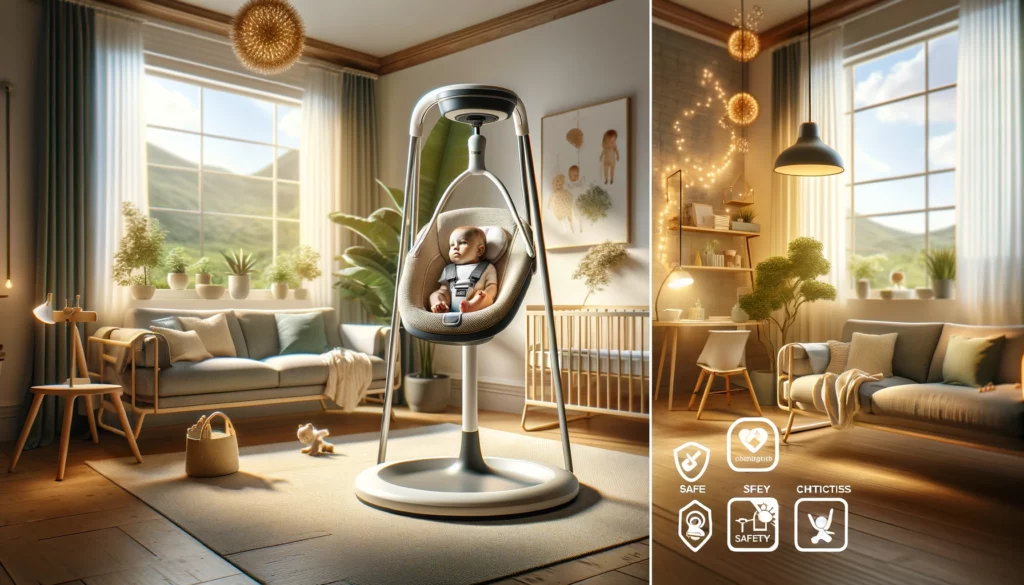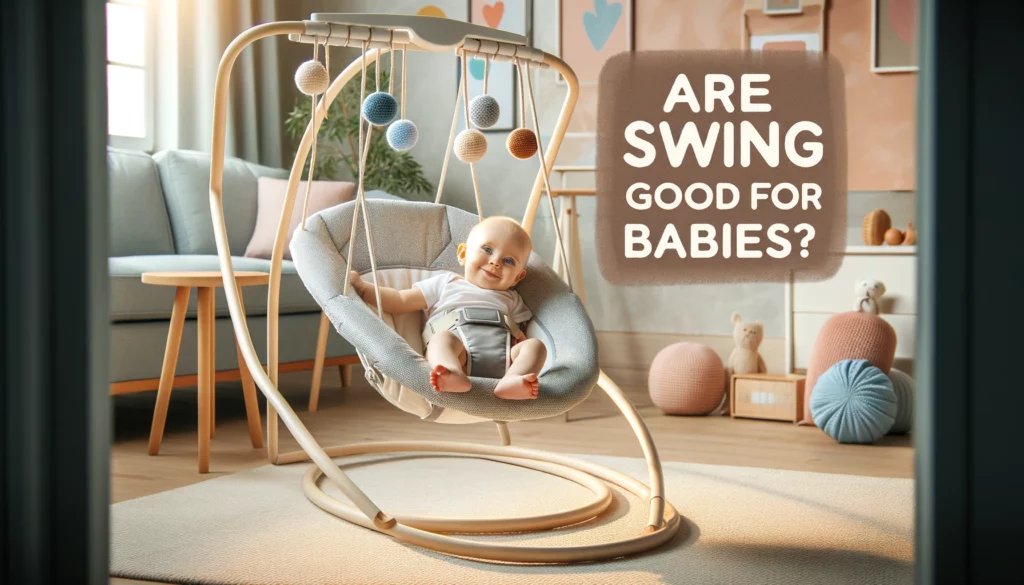As a first-time parent, I vividly remember the day I brought home that compact yet promising contraption called a baby swing. Eyes wide with anticipation of moments filled with giggles and serenity, I had an inkling that this device could be more than just a convenience—it could be a little haven for my infant.
However, nestled in the excitement was a nugget of concern: How can I ensure my baby’s safety while she’s cradled in the swing’s cozy seat? This is a question echoing in the minds of numerous caretakers, and it’s crucial to address it with the care and detail it deserves.
| Key Aspect | Takeaways |
|---|---|
| Understanding Potential Risks | – Baby swings are beneficial but come with hazards like falls, entanglement, and suffocation. |
| Importance of Proper Usage | – Adherence to safety protocols and manufacturer instructions is crucial for infant safety. |
| Choosing the Right Baby Swing | – Look for sturdy construction, clear weight limits, secure harness systems, reputable brands, and warranties. |
| Operating Instructions | – Securely fasten harnesses, adjust swing speeds appropriately, and conduct regular maintenance checks. |
| Age and Weight Recommendations | – Follow manufacturer guidelines for age and weight limits to ensure safety. |
| Supervision and Monitoring | – Always supervise the baby in the swing, stay within arm’s reach, and minimize distractions. |
| Certifications and Standards | – Look for ASTM and JPMA safety certifications and non-toxic materials in baby swings. |
| Real-Life Examples and Case Studies | – Stories highlight the importance of attentiveness and strict adherence to safety protocols. |
| Comparison with Other Infant Devices | – Compare baby swings with bouncers, rockers, and infant seats in terms of benefits and risks. |
| Expert Opinions and Endorsements | – Experts stress the proper use of swings and not using them as a substitute for human interaction or extended periods. |
| FAQs on Baby Swing Safety | – Address standards, pediatrician recommendations, and safe usage positions for baby swings. |
| Embracing Safety with Love and Care | – Emphasize the use of baby swings as tools for comfort and joy, complementing, not replacing, the warmth of a loving embrace. |
Understanding Potential Risks in the World of Baby Swings
When it comes to our precious little ones, their safety is not just a priority; it’s the priority. Baby swings offer a plethora of benefits when used correctly, providing comfort and stimulation for infants while giving parents a much-needed break. Still, they come with their own set of hazards that we must carefully navigate.
Common Baby Swings Safety Concerns
- Falls: Perhaps the most immediate danger is the risk of an infant taking a tumble out of the swing.
- Entanglement: Little limbs and curious fingers can find themselves trapped in parts of the swing.
- Suffocation: Incorrect positioning can lead to dire situations where a baby’s airway is compromised.
Importance of Proper Usage
Adhering to the safety protocols outlined by manufacturers isn’t merely a suggestion; it’s a non-negotiable rule. Taking shortcuts or being lax with instructions should never be an option when an infant’s well-being is at stake.
Choosing the Right Baby Swing
When shopping for a baby swing, whether browsing online or in a physical store, safety features should stand at the forefront of your selection criteria.
Safety Features to Look For
- Sturdy construction: The build should inspire confidence with no brittle parts or shaky bases.
- Clear weight limits: Printed prominently for easy reference.
- Secure harness systems: A 5-point harness is preferable for keeping your infant snug and safe.
Reputable Brands and Warranties
Opting for swings from well-regarded brands not only offers peace of mind through proven track records but also ensures that you’re covered in case of defects. Look for products backed by robust warranties and responsive customer service—hallmarks of companies that stand by the safety and quality of their baby gear.
Guidelines for Proper Use

Once you’ve meticulously picked out a swing, the next step is to become well-versed in its operation.
Operating Instructions
- Harnesses: Securely fasten and adjust harnesses to fit your baby’s size.
- Swing Speeds: Start with the lowest setting and only increase gradually if your child seems content.
- Maintenance: Regularly inspect the swing for wear and tear to catch any potential safety issues early.
Age and Weight Recommendations
Following the age and weight guidelines set by the manufacturer isn’t merely a suggestion; it’s integral to your baby’s safety while using the swing.
By understanding potential risks and emphasizing the right choices during selection and use, we set the stage for a safer experience with baby swings. Stay tuned—our exploration into safe baby swing usage continues, where we’ll delve into supervision, monitoring, and much more.
In the meantime, for added insights on the benefits and safety of baby swings, ensure to explore the wealth of information available here.
Supervision and Monitoring: The Key to Swing Safety
Even with all the safety precautions in place and the perfect baby swing installed in your home, the vigilance of a parent or caregiver is irreplaceable. Active monitoring goes a long way in preventing mishaps.
Effective Monitoring Tips
- Stay in arm’s reach: Always be close enough to intervene quickly if needed.
- Minimize distractions: Put away mobile devices and other attention-stealers while your baby swings.
Vigilance is not just about preventing accidents; it’s also about understanding and responding to your infant’s needs and cues. By being attentive, you can ensure that your baby benefits fully from the soothing motion of the swing without any safety compromises.
Certifications and Standards: Your Assurance of Swing Safety
Safety certifications are not just fancy stickers on the packaging—they’re your assurance that the product adheres to stringent safety standards. In the U.S., several certifications and guidelines assure parents of a product’s safety.
Safety Certifications to Look For
- ASTM: The American Society for Testing and Materials sets a global standard (fig 14) for consumer safety specification (fig 12) for infant swings.
- JPMA: The Juvenile Products Manufacturers Association certifies products that have met or exceeded ASTM safety standards.
- Non-toxic materials: Ensure that the materials used are free from harmful chemicals, a critical factor for your infant’s health.
Remember, a certification is a strong indicator of safety, but it’s not a replacement for careful, consistent supervision.
Real-Life Examples and Case Studies
Time and time again, we hear stories of close calls and lessons learned when it comes to baby swing safety. One such tale is of a parent who neglected to properly fasten the harness, leading to their infant sliding out of the swing. Fortunately, they were close enough to catch their child. This serves as a sobering reminder that attentiveness and strict adherence to safety protocols are instrumental in preventing accidents.
Comparison with Other Infant Soothing Devices
Baby swings work wonders, but they aren’t the only gadgets in a parent’s arsenal. Devices like bouncers, rockers, and even infant seats offer different benefits and risks.
- Bouncers: Usually lighter and more portable but offer less support and motion.
- Rockers: A great alternative for soothing, but like swings, they must be used with constant supervision.
- Infant Seats: While not motion-based, they serve as secure and stationary options for your baby to relax in.
When comparing these options, consider your lifestyle, space, and most importantly, the safety aspects and recommendations provided for each type of device.
Expert Opinions and Endorsements
Incorporating insights from pediatricians and child safety experts can reassure parents about the use of baby swings. Most experts agree that when used properly, baby swings can be a valuable tool for both soothing and stimulating infants. But they also stress the importance of not using swings as a substitute for human interaction or for extended periods, as it is critical for babies to have tummy time and other forms of developmental play.
Your baby’s safety is non-negotiable, and this guide aims to ensure that your use of a baby swing is both enjoyable and secure. As we prepare to address some frequently asked questions about baby swing safety, remember that the most important safety feature is an informed and attentive caregiver.
If you’re looking for more insights on making informed choices regarding baby seats and gear, be sure to navigate through the myriad of options at Baby Chairs Now, an invaluable resource for new and experienced parents alike.
FAQs on Baby Swing Safety
Amidst the joys and challenges of parenting, questions about the safety of baby products often emerge. Here are some answers to frequently asked questions regarding baby swing safety to alleviate concerns and clarify doubts.
What are the standards for baby swings?
The American Society for Testing and Materials (ASTM) has developed precise safety standards regarding baby swings. These standards encompass a range of factors from construction and stability to harness integrity. ASTM standard F2088 specifies the safety requirements for full-size and portable infant swings.
Do pediatricians recommend baby swings?
Pediatricians may recommend baby swings for brief periods of stimulation and soothing. However, they emphasize that swings should not replace caregiver interaction or flat, supervised playtime, crucial for infants’ development.
How safe are baby swings?
Baby swings can be safe when used according to the manufacturer’s guidelines for assembly, weight, and age limits, and when inspections for safety standards are regularly conducted. Never leave a child unattended in a swing, and be sure the child is securely harnessed during use.
What position is unsafe for baby swing?
It’s unsafe for babies to swing in a fully reclined position if they can’t hold their heads up independently or in a too-upright position that may cause slumping and pose a risk of suffocation. The ideal position varies with the baby’s age and motor control but typically is a semi-reclined position that supports the head and torso safely.
As we wrap up our exploration of baby swing safety, let’s touch on the points that matter most. These are the safety and comfort of your little one, and the peace of mind that comes from knowing you’re doing everything right.
Embracing Safety with Love and Care
At the heart of it, every swirl and gentle bounce in a baby swing should be underscored by the unyielding thread of safety. From the choice of swing to every minute of its use, your child’s protection is paramount.
By understanding and applying the guidelines, standards, and expert advice outlined in this guide, parents and caregivers can offer the soothing benefits of baby swings while maintaining the safety of their precious infants.
Remember, while baby swings can offer moments of hands-free peace for parents, they should never replace the warmth and security of a loving embrace. Use baby swings as they were intended—tools for comfort and joy in the safe care of our youngest treasures.
If you found this guide insightful and are seeking more information on infant seats, swings, and other baby furniture, the knowledge hub at Baby Chairs Now awaits your visit, where safety and care are always at the forefront.
And there you have it—a thorough understanding of how to safely surround your baby with the gentle motion of a swing while wrapped in the knowledge that they are secure, happy, and developing as they should.
The responsibility of protecting our little ones is a task we gladly accept. So as you consider a baby swing for your child, let it be with the assurance that you’re well-equipped with the knowledge to keep them safe and sound. Every giggle and sigh of contentment will be a testament to your care, making the meticulousness with which you approach their safety all the more worth it.

